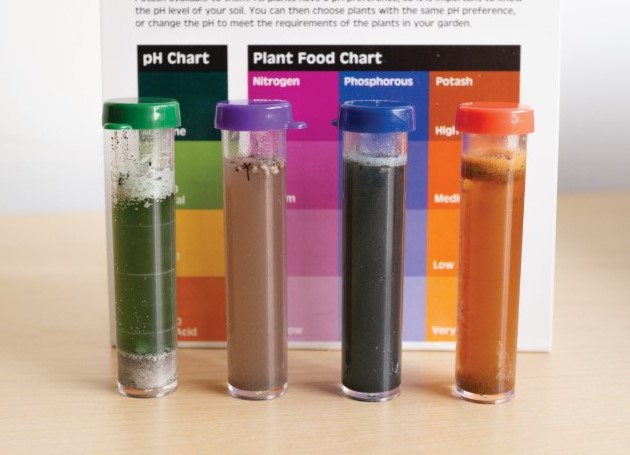Soil Testing: Test Kits vs. Laboratory Analysis

Color based soil test kit. Image by MSU Communications
There are several factors that people need to consider when choosing a soil test kit to make fertilizer decisions, these include how the soil is prepared, the actual test used, how results are presented, cost, and the accuracy of results.
Test kits generally measure nitrogen (N), phosphorus (P), potassium (K) and soil pH. These are appropriate basics, though a laboratory test can also measure salts or a host of other nutrients, such as iron (Fe), which may be important for gardeners to know.
Most soil test kits require combining the whole soil sample with water to make a slurry. In contrast, soil testing laboratories dry, sort, grind and sieve soil samples to remove rocks and residue before analysis.
Particularly important is the quality and shelf-life of the reagents (chemical liquids) mixed with the soil to perform each test. Laboratories have standard practices to ensure their materials are not out-of-date. Just like using outdated milk, using an old batch of reagent might not have desirable results. A market gardener cooperative or garden club may use 100 samples’ worth of material provided in an elaborate kit in a timely manner, while a home gardener likely would not.
Soil test kits may not include the correct P test. Montana State University fertilizer guidelines are based on Olsen P, which is reliable across a range of pH and calcium carbonate levels. There is a strong correlation between Mehlich-3 and Olsen P. If only the Mehlich-3 (M3) test is available, convert Mehlich-3 to Olsen P (Olsen P = M3/2.05 - 14). Using this conversion, the MSU P fertilizer guidelines can be used, with caution, to calculate approximate P fertilizer rates. Both the Bray and Haney (H3A) tests are not suitable for Montana soils.
Many test kits provide results with a word-based rating of “low,” “medium” or “high” — or “deficient,” “adequate” or “surplus” — rather than in a unit value, such as parts per million (ppm) or pounds per acre (lb/acre). Fertilizer rates are essentially impossible to determine from these ‘qualitative’ ratings. Laboratories report actual test concentrations and fertilizer recommendations based on field trials that relate fertilizer rates and soil test values.
An article in “Crops & Soils,” which is published by the American Society of Agronomy, compared results from four test kits with laboratory test results. Only the by-far most expensive and elaborate kit provided the option to use the Olsen P test and produced test results for N and P that were very similar to laboratory results. Potassium results were only reliable at low to moderate K levels (less than 250 ppm). The simpler, less expensive, kit results differed moderately or even greatly from laboratory results.
Test kits can be cheaper and more convenient than using a lab, but the savings may not be worth low-accuracy results. Kits cost in the range of $15 for 10 samples to $750 for 100 samples. Although lab fees can vary from around $15 to over $50 per sample, accurate results are available from labs with low fees. It is better to spend $15 on accurate results than base fertilization on erroneous results, and potentially cause fertilizer waste, environmental degradation or lost production.
Test kits provide quick results, while sending samples to a lab might require a few days before results are available. Laboratories can have quick turnaround. Soil pH meters are available for on-site testing and immediate results. Meters are more reliable than color test strips, because interpretation of a color is more subjective than reading a number.
Soil test results are only as good as the sample collected and laboratory analysis performed. The Soil Scoop Soil Testing: Getting a Good Sample explains sampling steps and lab selection. County agriculture Extension agents can also likely help people choose a laboratory.
Soil health tests are a whole additional topic. These can be valuable to assess management, but standardized methods may not yet be in place and calibration is lacking between test results and appropriate fertilizer requirements. Soil health testing is discussed in The Soil Scoop Evaluating Soil Quality and Health and The Soil Health Gap.
For more information:
MSU Extension Soil Fertility: Vegetable and Home Gardens
Soil Sampling Strategies (MT200803AG)
Interpretation of Soil Test Reports for Agriculture (MT200702AG)
MSU Nutrient Management Module
Module 1 - Soil Sampling and Laboratory Selection
Reviewed July 2025

